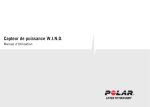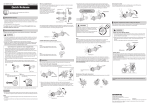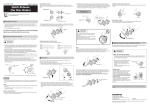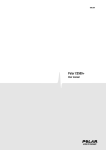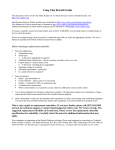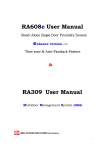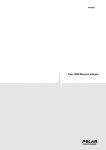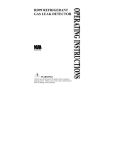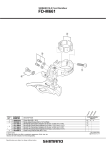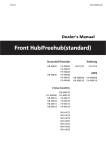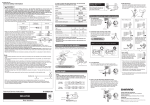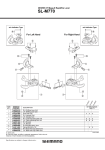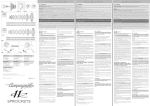Download ENGLISH
Transcript
ENGLISH ENGLISH ENGLISH Contents 1. PRODUCT ELEMENTS.......................... 3 Teaching ...................................11 Settings ....................................12 2. INTRODUCTION ................................ 4 3. INSTALL POWER SENSOR MAIN UNIT ........ 5 Install Cadence Magnet ................... 6 4. INSTALL BATTERY CASE ...................... 7 5. INSTALL CHAIN SPEED SENSOR .............. 8 6. VERIFICATION OF THE SENSOR INSTALLATIONS .............................. 10 7. POWER SETTINGS FOR CYCLING COMPUTER ................................... 11 8. CUSTOMER SERVICE INFORMATION ......... 14 Care and Maintenance ...................14 Power Output Sensor Battery ............15 Frequently Asked Questions .............16 Technical Specifications .................17 Limited International Polar Guarantee..18 Disclaimer .................................20 ENGLISH 1. PRODUCT ELEMENTS Product Elements 3 ENGLISH 2. INTRODUCTION The drive force of a bike is transmitted entirely through the chain, allowing the cycling computer to calculate watts very accurately. The system works by measuring two key factors: • • Chain Tension - measured with the Power Output Sensor main unit Chain Speed - measured with the Chain Speed Sensor Together with the Polar Cycling Computer, Polar Power Output Sensor measures • • • • Actual, average and maximum Power values, Left/Right Balance (distribution of power between left and right legs), Pedaling Index (how even the power is distributed during a crank arm rotation), and Cadence 4 Introduction For training purposes, Power Output Sensor provides much more precision than heart rate measurement and perceived exertion. Power measurements also have a number of other uses, including bike positions and determining efficiency at different cadences among others. Polar Power Output Sensor is suitable only for road bikes, ridden on tarmac. It is not suitable for mountain bikes or bikes with very complex rear stays. For more instructions on how best to benefit from the Power Output Sensor, please see the Polar Cycling Computer user manual. ENGLISH 3. INSTALL POWER SENSOR MAIN UNIT To install the Power Output Sensor, you will need 10 mm wrench, 3 mm Allen key, a chain breaker, scissors, measuring tape and rubber gloves. Attach the Power Output Sensor main unit to the top of the right chain stay, so that the wires are directed backwards. Position the sensor just on the top of the chain stay, not leaning to either side (picture 1). Disconnect the electric wires from the main unit before installing. Before installing the main unit, measure the span length as instructed on page 12. The main unit must be placed in such a way that the dot on the upper side of the unit (picture 2 a) is exactly in the middle of the chain stay. The ideal place for the sensor is as close to the chain as possible without the chain touching it (about 2mm/0.08”) in the small/small chainring/cog combination. Depending on your frame, it may be necessary to put supporting pieces under the sensor. Note that there are supporting pieces of three sizes in the set. Before attaching the supporting pieces for the sensors or the magnet to the bicycle, the area in question should be cleaned and dried thoroughly. The sensor should be attached directly under the chain (picture 1). The measurement is most accurate when the chain runs just over the sensor's central axis. Make sure that the crank doesn’t hit the unit when pedaled. Pass the cable ties through the sensor holes and around the chain stay. Do not wind them around the gear cable. Adjust the ties loosely. Do not tighten the cable ties of the sensor fully before installing the cadence magnet. Install Power Sensor Main Unit 5 ENGLISH Install Cadence Magnet When you install the cadence magnet, the chain should be on the largest front chainring. This way you can make sure that the chain does not touch the magnet. Install the cadence magnet inside of the crank (picture 1 and 2 b). To ensure successful transmission of cadence signals, the cadence magnet should pass the "cadence notch" on the power sensor. Attach the magnet to the crank arm so that it passes the sensor closely but does not touch it. The maximum distance between the power sensor and the cadence magnet should be 7 mm / 0.3". Secure the magnet with tape. Tighten the cable ties around the main unit and cut off any excess ends. 6 Install Power Sensor Main Unit ENGLISH 4. INSTALL BATTERY CASE Attach the battery case to the seat stay, on the same side of the bike as the power sensor main unit (picture 3). Pass the cable ties through the battery case holes and around the seat stay. Tighten the cable ties and cut off any excess ends. Also use cable ties to secure the battery case wire so that it is not hanging loosely. Choose the place for the Battery Case so that you can easily take out the battery holder when changing batteries. For more information, see Care and Maintenance. Install Battery Case 7 ENGLISH 5. INSTALL CHAIN SPEED SENSOR Wind the wire from the power sensor to the chain speed sensor securely around the rear derailleur cable, or use cable ties to secure the wire so that it is not hanging loosely. However, the normal operation of the rear derailleur must be possible. Avoid extreme tightening of the wire. There are three pulley bolts included in the package. Choose the most suitable bolt to install on your bike. The table on the following page includes the most commonly used rear derailleur types, but the bolts are suitable for many other types, as well. Detach the original bolt from the rear derailleur and replace it with one of the bolts delivered in the package. Install the chain speed sensor on bolt and tighten it with a locknut (picture 4). Do not tighten fully yet. 8 Install Chain Speed Sensor Check that • all gears function properly. • the wire is not too tight or loose with any gear. • chain speed sensor does not touch the spokes when the chain is on the largest sprocket. Tighten the pulley bolt on the rear derailleur. ENGLISH Rear derailleur Pulley bolt Shimano Shimano Dura-Ace RD-7700 Ultegra RD-6500 Shimano 105 RD-5500 XTR RD-952 Deore XT RD-M750 Deore LX RD-M570 Shimano #501030 Shimano Deore RD-M510 Tiagra RD-4400 Shimano #501031 Campagnolo Record 9-speed RD00-RE209 Chorus 9-speed RD00-CH209 Record 10-speed RD00-RE210, RD00-RE210l Chorus 10-speed RD00-CH210, RD00-CH210l Racing Triple 9-speed RD00-RA309 Daytona 9-speed RD00-DA209 Daytona Triple 9-speed RD00-DA309 Veloce 9-speed RD99-VL209 Veloce Triple 9-speed RD99-VL309 Mirage RD99-MI209 Mirage Triple RD99-MI309r Campagnolo #501032 Install Chain Speed Sensor 9 ENGLISH 6. VERIFICATION OF THE SENSOR INSTALLATIONS Test the Power sensor and cadence magnet installation by checking that the green indicator light flashes in the power sensor when the cadence magnet passes the "cadence notch" on the power sensor. Test the chain speed sensor installation by checking that the red indicator light flashes in the power sensor when the chain is rotated. This is only a testing procedure. The flashing will not continue after 50 flashes when cycling. If you want to check this procedure again, you must pause for one minute during which time the magnets must not pass the sensors and the chain must not move. 10 Verification of the Sensor Installations ENGLISH 7. POWER SETTINGS FOR CYCLING COMPUTER Teaching The cycling computer has to be coded to the power output sensor i.e. taught to receive power and cadence data. This enables exercising in a group without interference from other sensors. The power output sensor and cycling computer in the same product set have already been synchronized but teaching is necessary when you start using a new sensor that has been purchased separately. All three bike settings can be coded to a different sensor. The procedure takes only a few seconds. Install the power sensor to your bike as advised. Make sure that there are no other power output sensors nearby (40 m / 130 ft). Select Settings > Bike > Bike 1/2/3 > Power . Select On/Off and On to turn the power function on. Press OK. • Select YES to confirm teaching. Start test drive is displayed. Rotate the crank a few times to activate the sensor. The flashing red light in the sensor indicates that the sensor is activated. Completed is displayed after the teaching has been finished. The cycling computer is now ready to receive power data. • Select NO to cancel the teaching. The teaching is cancelled and the cycling computer remains coded with the previous power sensor used. To return to Time mode, press and hold the BACK button. Power Settings for Cycling Computer 11 ENGLISH Settings Set chain weight, chain length and span length To use the Polar Power output sensor you need to have the following settings on your cycling computer. Start by selecting Settings > Bike > Bike 1/2/3 > Power . Select Settings > Bike > Bike 1/2/3 > Power > Turn Power function On/Off • Settings • On: Teach new sensor? is displayed. • • Select No if you don’t need to change the sensor. Confirm with Yes and Start test drive as advised. When teaching is accomplished, Completed appears. Off: Exercise displays updated is displayed. If you choose to Turn Power function off the Power data will be removed from all the displays concerning the Bike in question. 12 Power Settings for Cycling Computer • Chain weight (g): If you do not know the default factory value, remove the chain and weigh it. Chain length (mm): If you do not know the factory default value, count the number of loops and multiply the amount by 12,7 mm. Span length (mm): measure the distance from the centre of the rear hub to the centre of the bottom bracket as shown in the picture 5. ENGLISH Examples of chain weights and lenghts: Shimano Dura-Ace CN-7700 Super narrow HG weight: 280 g length: 1473 mm Shimano Dura-Ace CN-7701 Ultegra CN-HG92, 105 HG72,105 HG73 weight: 280 g length: 1473 mm Shimano Sora CN-HG50 weight 335 g length: 1473 mm Due to the variation of the measurements, Polar cannot be held responsible for their validity. For precise readings, all settings must be as accurate as possible. Chain length and weight are directly proportionate to power value. If they have, for example, 1% error, then the Power Value will also have this 1% error. There is no need to re-enter chain length and weight if links are removed. The system uses chain density (weight/length). Removing links from the chain does not affect density. Campagnolo Record 2000, 10 Speed Chain weight: 260 g length: 1473 mm Campagnolo 10 Speed Chains Chorus, Centaur weight: 274 g length: 1473 mm Campagnolo Veloce, Mirage, and Xenon weight: 277g length: 1473 mm Power Settings for Cycling Computer 13 ENGLISH 8. CUSTOMER SERVICE INFORMATION Care and Maintenance Before you start cycling, check that your handlebars turn normally, brakes and all gears function properly, the cables are kept out of the sprockets, all sensors are installed securely and no surplus wires are hanging loosely. Please note that installation and maintenance not carried out according to this manual may result in a serious accident. Polar Power Output Sensor is splash proof. This means that you can use the sensor in the rain and wash it with water. However, do not wash any part of the Power Output Sensor with a pressure washer or immerse any part of the system under water. 14 Customer Service Information Clean the sensor with a mild soap and water solution, dry with towel. Never use alcohol or any abrasive material (steel wool or cleaning chemicals). The sensors contain strong magnets that may damage diskettes, magnetic cards such as credit cards, or other electromagnetic equipment. ENGLISH Power Output Sensor Battery The estimated average battery life of the Polar Power Output Sensor is 50 riding hours. To change the batteries, please follow these instructions (picture 6). Open the battery case and take out the battery holder. Change the batteries (battery type AAA) and insert the battery holder, minus side first. Do not throw the old batteries away with normal waste; batteries should be disposed of properly according to local regulations. Keep batteries away from children. If swallowed, contact a doctor immediately. Customer Service Information 15 ENGLISH Frequently Asked Questions ...there are irregular power or cadence readings? What should I do if... • ...Check Power is displayed? • Make sure your power sensor is positioned correctly. Rotate the crank a few times to activate the sensor. The flashing red light indicates that the sensor is activated. Also the battery of your power sensor may be empty. For further information, see Care and Maintenance. • ...the power or cadence reading is 0 or there is no reading while cycling? • • • • Check that the sensor and the cadence magnet are installed according to instructions. Check that you have set correct power/cadence settings in your cycling computer, and activated the power/cadence function. If the 0 reading appears irregularly, this may be due to temporary electromagnetic interference in your current surroundings. If the 0 reading is constant, you may have exceeded 50 riding hours and the battery is empty. 16 Customer Service Information Electromagnetic interference as well as interference from other wireless cycling computers may affect readings of power and cadence. Disturbances may occur near high-voltage power lines, traffic lights, overhead lines of electric railways, electric bus lines or trams, WLAN base stations, car motors, cycling computers, some motor driven exercise equipment, cellular phones, or when walking through electric security gates. Frame material may affect the transmission range. ...Sensor not found and Try again? are displayed: • Press OK to start seeking and rotate the crank a few times to activate the sensor. ENGLISH Technical Specifications 0 °C to +50 °C / 32 °F to 122 °F Operating temperature: Batteries: Battery life: Accuracy of power output measurement: Weight of the sensors and the bike mount: Water resistance: Splash proof Measurement ranges Average power: LR balance: Pedaling index: Cadence: 0-2000 W 1 - 99 % 0 - 100 % 0 - 199 rpm two AAA type batteries average 50 riding hours average ±5% (range 50 - 1000 W). Momentary differences may occur. 222 g (including batteries) Customer Service Information 17 ENGLISH Limited International Polar Guarantee • • • • This limited Polar international guarantee is issued by Polar Electro Inc. for consumers who have purchased this product in the USA or Canada. This limited Polar international guarantee is issued by Polar Electro Oy for consumers who have purchased this product in other countries. Polar Electro Inc./Polar Electro Oy guarantees to the original consumer/purchaser of this product that the product will be free from defects in material or workmanship for two years from the date of purchase. Please keep the receipt, which is your proof of purchase! The guarantee does not cover the battery, damage due to misuse, abuse, accidents or non-compliance with the precautions, improper maintenance, commercial use, and cracked or broken cases. 18 Customer Service Information • • The guarantee does not cover any damage/s, losses, costs or expenses, direct, indirect or incidental, consequential or special, arising out of, or related to the product. During the guarantee period the product will be either repaired or replaced at an authorized service center free of charge. This guarantee does not affect the consumer’s statutory rights under applicable national or state laws in force, or the consumer’s rights against the dealer arising from their sales/purchase contract. This product is compliant with Directive 93/42/EEC. The relevant Declaration of Conformity is available at www.support.polar.fi/declaration_of_conformity. ENGLISH This crossed out wheeled bin marking shows that Polar products are electronic devices and are in the scope of Directive 2002/96/EC of the European Parliament and of the Council on waste electrical and electronic equipment (WEEE). These products should thus be disposed of separately in EU countries. Polar encourages you to minimize possible effects of waste on the environment and human health, also outside the European Union by following local waste disposal regulations and, where possible, utilizing separate collection of electronic devices. All rights reserved. No part of this manual may be used or reproduced in any form or by any means without prior written permission of Polar Electro Oy. The names and logos marked with a ™ symbol in this user manual or in the package of this product are trademarks of Polar Electro Oy. The names and logos marked with a ® symbol in this user manual or in the package of this product are registered trademarks of Polar Electro Oy. Copyright © 2007 Polar Electro Oy, FIN-90440 KEMPELE, Finland. Polar Electro Oy is a ISO 9001:2000 certified company. Customer Service Information 19 ENGLISH Disclaimer • • • The material in this manual is for informational purposes only. The products it describes are subject to change without prior notice, due to the manufacturer’s continuous development program. Polar Electro Inc. / Polar Electro Oy makes no representations or warranties with respect to this manual or with respect to the products described herein. Polar Electro Inc. / Polar Electro Oy shall not be liable for any damages, losses, costs or expenses, direct, indirect or incidental, consequential or special, arising out of, or related to the use of this material or the products described herein. This product is protected by one or several of the following patents: US6199021, US6356848. Other patents pending. 20 Customer Service Information





















